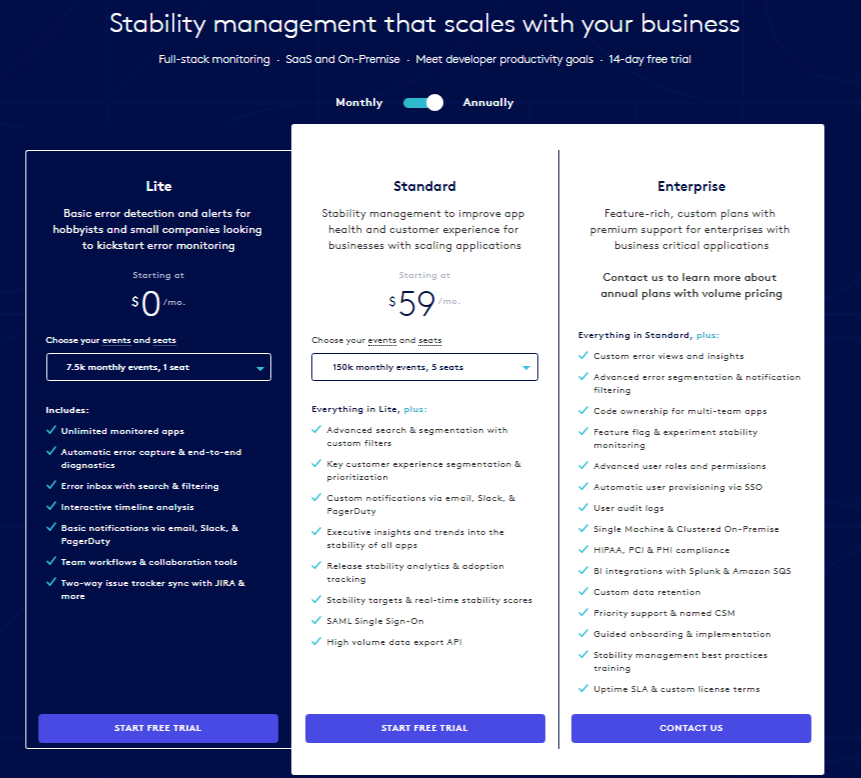This Bugsnag pricing section is effective for several reasons:
1. Clear Hierarchy and Visual Appeal:
- Distinct Tiers: The “Lite,” “Standard,” and “Enterprise” tiers are clearly labeled and visually separated.
- Consistent Layout: Each tier follows a consistent layout with descriptions, pricing (where applicable), features, and call-to-action buttons.
- Visual Cues: Checkmarks are used to indicate included features, enhancing readability.
- Clear Headings: The headings clearly indicate the purpose and target audience of each tier.
- Pricing Clarity: The monthly prices are prominently displayed for the “Lite” and “Standard” tiers.
- Call to Action Buttons: The “START FREE TRIAL” and “CONTACT US” buttons are visually distinct and clearly labeled.
- Billing Options: The “Monthly” and “Annually” toggle allows users to easily compare billing options.
- Free Trial Offer: The 14-day free trial message is displayed at the top of the pricing section.
2. Value-Based Differentiation:
- Targeted Descriptions: Each tier has a concise description that clearly identifies the target customer and their needs.
- Feature Progression: The “Everything in [Previous Tier], plus:” structure clearly highlights the added value of higher tiers.
- Specific Feature Differentiation: Features like “Custom error views and insights,” “SAML Single Sign-On,” and “HIPAA, PCI & PHI compliance” differentiate the higher tiers.
- Quantitative Differentiation: The differences in monthly events and seats provide clear quantitative differences.
- Free Option: The “Lite” tier offers a free option, lowering the barrier to entry.
3. Transparent Pricing:
- Clear Pricing Information: The monthly prices are clearly stated for the “Lite” and “Standard” tiers.
- Contact for Pricing: The “Enterprise” tier uses “Contact us,” indicating a tailored solution for larger clients.
- Choose Events and Seats: The dropdown option for events and seats allows for a level of customization.
4. Addressing Different User Needs:
- Hobbyists and Small Companies: The “Lite” tier caters to hobbyists and small companies with basic needs.
- Scaling Applications: The “Standard” tier is designed for businesses with scaling applications needing improved app health.
- Business-Critical Applications: The “Enterprise” tier caters to enterprises with business-critical applications needing feature-rich, custom plans.
5. Strategic Use of Information:
- Benefit-Oriented Features: Features like “Automatic error capture & end-to-end diagnostics,” “Release stability analytics & adoption tracking,” and “Priority support & named CSM” highlight the value of each tier.
- Clear Call to Action: The call-to-action buttons provide clear paths for action.
- Feature Lists: The feature lists clearly show the differences between the tiers.
- Concise Descriptions: The descriptions are brief and to the point, making it easy to understand the purpose of each tier.
- Trial Incentive: The 14-day free trial incentivizes users to try the product.
- Billing Toggle: The monthly/annual toggle lets users see the difference in costs.



